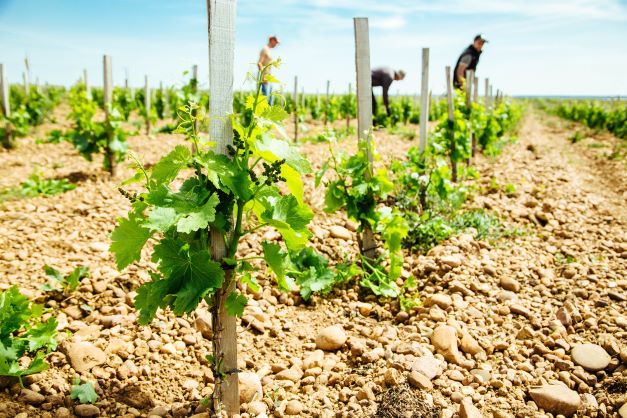Winter is the ideal time for planting new vineyards. «What and how to plant ?» is the question that the winemaker asks. The answer depends on what is anticipated in terms of climate and market trends. This is a complex exercise because a vineyard is established for the next 30 years or more, while climate and market forecasts are rather unclear at such a distance.
Before starting, it should be noted that a vine plant consists of a rootstock (resistant to phylloxera, it constitutes the root part of the plant) and a scion (the grape variety that is to be grown). This is a double choice that is not found in all types of crops.
The first step involves choosing the rootstock. It is established first according to the soil (deep or superficial, moist or dry, limestone or acidic, rich or poor, compact or soft) and, to a lesser extent, the microclimate (early or late). We dig pits and conduct analyses to qualify the soil we will plant in.
The combination of climate change and our practice of plant covers leads us to return to more vigorous rootstocks that are resistant to drought and often tend to delay ripening. This is currently the most powerful means we have to combat climate change.
The second step is the choice of planting density and training system. Again, our strategy is evolving towards lower densities to leave a larger root exploration zone for each plant to resist periods of drought. Similarly, we raise the height of our cordons to better resist spring frost, without increasing the height of foliage to limit evapotranspiration and avoid too rapid ripening.
Finally, the third step is the choice of scion, and thus the grape variety, for which we must balance

what is suitable for the terroir, what is suitable for its rootstock, what is allowed by the AOP, and what is suitable for the market for the next 30 years. We need to use a crystal ball…
We have chosen to prioritize white grape varieties, preferably late-maturing ones, with moderate alcohol content and beautiful acidity at maturity. Therefore, we had to deviate from the choices proposed by the Costières de Nîmes appellation. We are planting this year:
Carignan blanc : a natural mutation of the red variety, it is an endemic grape variety of the Mediterranean region. Still relatively unknown, it is a late-maturing grape, slightly aromatic, moderately sugary, allowing the production of mineral and taut wines with beautiful acidity. We plan to use it to enhance Rhône blends that are sometimes too opulent. For our Bulle de Nages ?
Colombard : originating from the Southwest, this late-maturing grape is very aromatic (passion fruit, grapefruit), reaching maturity with moderate alcohol potential and beautiful acidity. It now enters into the blend of Liberty Nages and contributes to its typicity.
Ugni blanc : also originating from the Southwest, this grape has a relatively discreet aroma, but at maturity it becomes moderately sugary and has good acidity. We also count on it to enter the blend of Liberty Nages.
We believe in both the suitability of our terroir for the production of fresh, quality white wine and in the development of consumption of this type of wine. It is up to us to make the right choices in the vineyard and then in the cellar to offer you beautiful tasting experiences.
Michel Gassier
To enter our website, you must be of legal drinking age in your country.